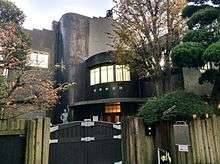Asakura Museum of Sculpture
| 台東区立朝倉彫塑館 | |
 Entrance to the museum | |
| Former name | Sakura Carving and Sculptures Museum |
|---|---|
| Established | 1967 |
| Location | Taitō Ward, Tokyo, Japan |
| Coordinates | 35°43′37″N 139°46′07″E / 35.726879°N 139.768543°E |
| Type | Art museum |
| Public transit access | Nishi-Nippori Station |
| Website | http://www.taitocity.net/zaidan/asakura/ |
Asakura Museum of Sculpture (台東区立朝倉彫塑館 Taitō kuritsu asakura chōsokan) or Asakura Choso Museum is an art museum in Taitō Ward in Tokyo, Japan dedicated to the life and work of Japanese sculptor Fumio Asakura (1883-1964), opened in 1967.[1] The museum is in the older Yanaka neighborhood of Taito, Tokyo, and preserves Asakura's home and his sculpture studio.
Asakura graduated from the Tokyo School of Fine Arts in 1907, and he built a small studio and house at this location. He bought more land, and by 1935 had constructed the present house and attached large studio. The three-story art studio was built of ferroconcrete, with a high ceiling and skylights to let in the natural light, and the walls painted a light-brown color for a warmer effect. The studio also served as Asakura's private school, the Asakura Choso Juku ("Asakura School of Plastic Arts") from 1920 to 1944, where he trained many young sculptors. The building includes the oldest extant roof garden in Tokyo, where Asakura's students learned gardening, growing radishes, turnips, and tomatoes, as part of the teaching process intended to sharpen their senses and familiarize them with nature.[1][2] The third-floor Orchid Room was originally a greenhouse for Asakura's collection of orchids, but is now used a gallery to display works depicting one of his favorite subjects, cats.
Asakura's house is also preserved, and its courtyard garden (旧朝倉文夫氏庭園) has been listed as a National Place of Scenic Beauty by the Japanese government's Law for the Protection of Cultural Properties.[3] The garden was designed by Sataro Nishikawa according to Asakura's conception, and is centered around five large rocks and water, and is intended to provide a three-dimensional aspect as befits the garden of a sculptor.[1]
The museum is open from 9:30 to 4:30, and closed on Mondays and Thursdays (except national holidays, when they close the day after), and during the New Year's period.